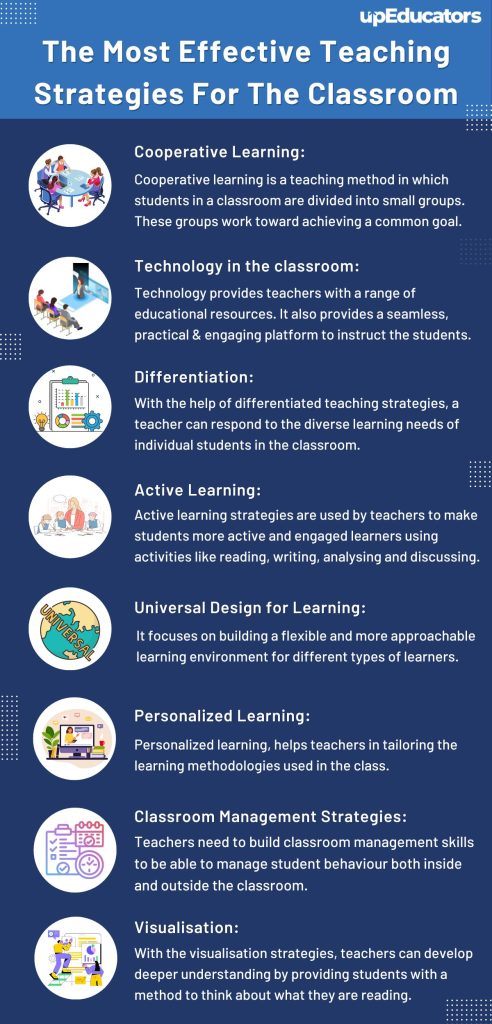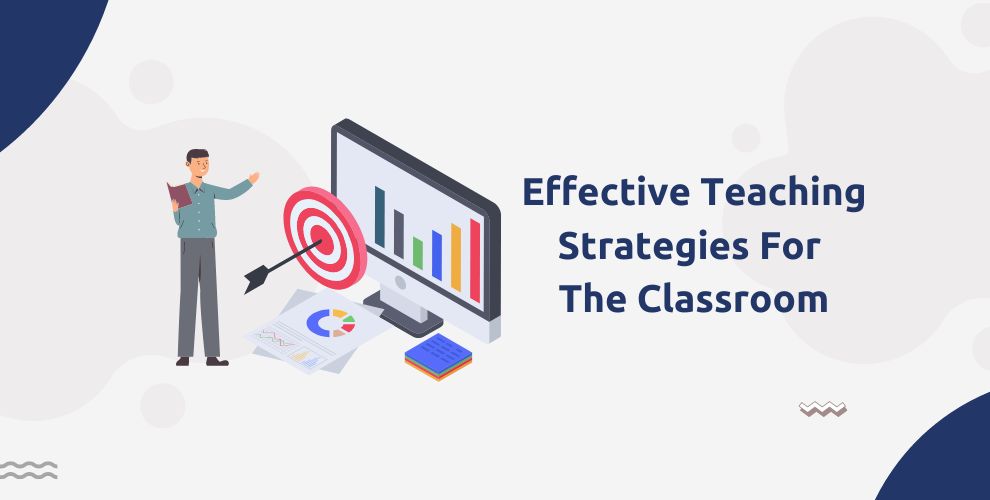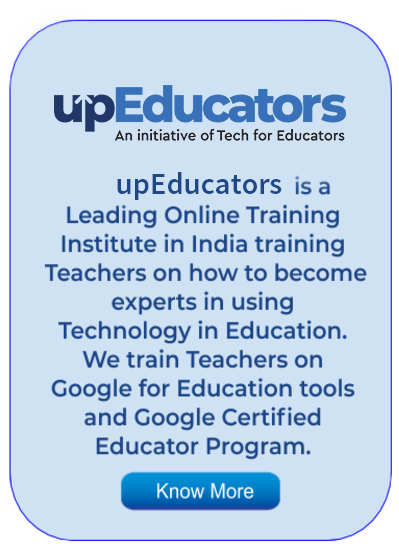The Classroom is a dynamic space. Every classroom consists of a mixed group of students. We have diverse learners with different socio-economic backgrounds. These students have different cognitive and learning styles. The biggest challenge for a teacher in such an environment is to use the right teaching strategies that make the classroom not only engaging but comfortable for every learning style.
In my experience as an educator with 14+ years of experience, the best way to engage learners is by using effective teaching strategies. There is no ‘one size fits all solution, so here is a range of effective teaching strategies you can use to inspire your classroom practice.

Cooperative Learning
A classroom comprises different individuals that make up a group. Cooperative learning is a teaching method in which students in a classroom are divided into small groups. These small groups work toward achieving a common goal or completing a similar task. Through this instructional strategy, teachers get to work on developing core competencies and brushing the soft skills of the students. Through cooperative learning, students learn to be interdependent, develop accountability and enhance interaction and participation in teamwork.
In my experience, some of the most popular Cooperative Learning activities used by teachers are Think-Pair-Share, Jigsaw, Round Robin and Numbered Heads Together.
Technology in the Classroom
Digital pedagogy is a must-have skill for teachers in the 21st century. Using technology and digital tools in the classroom is the most effective and versatile teaching strategy. Technology provides teachers with a range of educational resources. Furthermore, it also provides a seamless, practical and more engaging platform to instruct the students. Technology also enables teachers to integrate different learning styles in the classroom.
As an experienced educator, some digital tools that I recommend for teachers are Google Classroom, Nearpod, Book Creator, Kahoot, Microsoft Sway, Flip, Google Earth, One Note, Padlet and Quizlet.
Differentiation
As already mentioned, a classroom is full of varied minds with different cognitive abilities and learning styles. With the help of differentiated teaching strategies, a teacher can respond to the diverse learning needs of individual students in the classroom. When teachers approach solving a problem faced by an individual student, then differentiated teaching strategies are used by them. A lesson can be differentiated by altering the content, learning environment and the learning process.
Active Learning
Students become passive learners when they are only getting instructed by the teachers in the classroom. Active learning strategies are used by teachers to make students more active and engaged learners. Teachers can use activities like reading, writing analysing and discussing to make the class more active and engaging. In-class demonstrations, brainstorming, discussions and quizzes are some of the primary examples of active learning strategies.
In my years of experience, it has been noted that students who are engaged in the classroom using Active Learning methods can comprehend the concepts easily. Some of the most used active learning methods include One-Minute Paper, Think-Pair-Share, Show me boards, Reciprocal questioning, peer teaching and game-based learning.
Universal Design for Learning
Contrary to what the name suggests, Universal Design for Learning is an approach to instructing students that involves using a variety of teaching methods in the classroom. It focuses on building a flexible and more approachable learning environment for different types of learners. Using the UDL framework of teaching educators can use effective teaching strategies that benefit all types of learners who are a part of the classroom. The Universal Design for Learning focuses on making the learning process comfortable for people with disabilities in a classroom. But these strategies can be used to teach all groups of learners.
Personalized Learning
The road to learning is a non-linear path. Not every student learns at the same pace. Some students might have doubts about a topic while others understand the topic perfectly in the first attempt. A class will be filled with uninterested students if a teacher stops every 10 minutes to solve the doubts of a single student. Hence, more schools adopt personalised learning strategies. With the help of personalised learning, teachers can tailor the learning methodologies used in the class. Teachers need to understand and address the individual learning styles to adopt a personalised teaching strategy in the classroom.
Teachers in my schools would personalise students learning by using tools such as Google Classroom and Microsoft Teams. With Microsoft Teams, the teachers would create private channels where students were added to smaller groups so that teachers could share personalised learning materials as well as assignments with students. Using Google Classroom, teachers can share additional practice sheets with students who need additional support on any topic or challenging worksheets for high achievers. This can be shared with students individually using this platform.
Classroom Management Strategies
Teaching is not just about instructing. But classroom management is a major part of every teacher’s job. Teachers need to build classroom management skills to be able to manage student behaviour both inside and outside the classroom. For instance, keeping students disciplined during class hours is mandatory for a seamless learning experience. Teachers can learn classroom management skills and use them in the class to improve overall learning. Time-management skills, communication skills observational skills, having a positive attitude and maintaining discipline are some of the necessary classroom management strategies used by teachers.
According to my interactions with many teachers around the globe, a very popular app used by teachers to manage classroom behaviour is Class Dojo. Teachers use this application to give students positive points for good work done and negative points are awarded when they do not want the students to repeat the same negative behaviour. Parents have the access to their child’s points through the parents’ app and they could reinforce positive behaviour at home too.
Visualization
Reading is an essential part of learning. But visualisation goes hand in hand with reading. As the grade levels increase, the pictures in textbooks decrease and are replaced by more texts. Thus, students need to develop visualisation skills to be able to visualise the text that they read. With the visualisation strategies, we provide our students with a method to think about what they are reading. This develops a deeper and better understanding of a text.
Teaching involves dealing with different minds. Thus, one teaching strategy can’t be effective for teaching a bunch of students with different learning styles. A teacher needs to devise a plan for using effective teaching strategies to make the learning process simpler and more comfortable for every student. Learning styles may be different but an effective teaching strategy can make learning easier in a diverse classroom environment.
Author: This article is written by Sonam Chavan for upEducators blog.




